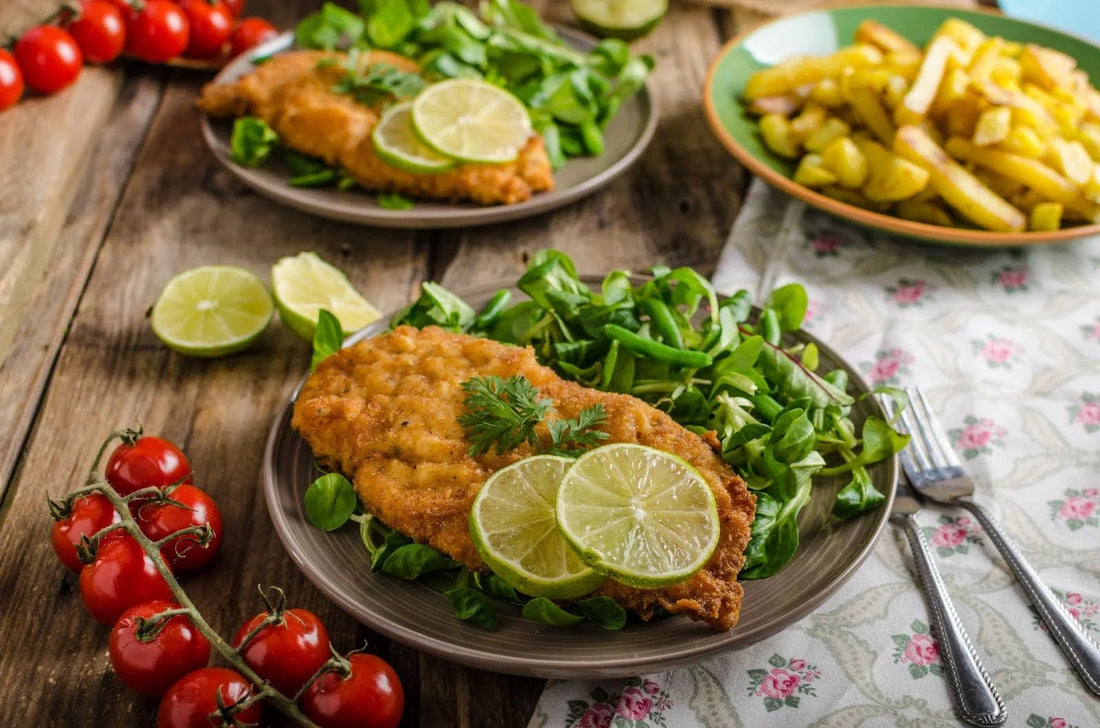
Cutlet vs Schnitzel: Which Crispy Dish Will Win Your Heart?
Teilen
The sizzle of hot oil, the satisfying crunch of golden breadcrumbs, and the tender meat beneath – few culinary debates spark as much passion as the eternal question of cutlet vs schnitzel. These two magnificent breaded meat dishes have conquered dinner tables across the globe, each boasting devoted followers who swear by their preferred preparation method.
Both dishes share a common foundation of meat coated in breadcrumbs and fried to crispy perfection, yet they carry distinct cultural identities. Schnitzel holds a place of honor in German-speaking countries, where it's treated almost like culinary royalty. Meanwhile, cutlets have spread their crispy wings across numerous cuisines, adapting to local tastes and ingredients wherever they land.
The beauty of this schnitzel vs cutlet debate lies not in declaring a winner, but in understanding what makes each dish special. Whether you're team cutlet or firmly planted in shnitzel territory, both offer that irresistible combination of textures and flavors that make comfort food so comforting.
We'll explore what makes a cutlet unique from its definition and origins, examine what defines a schnitzel from its traditional roots, and dive into the key differences between cutlet vs schnitzel, particularly focusing on meat and preparation differences that set these dishes apart.

What is a Cutlet?
Cutlets bring a mix of tradition and flexibility to the table.
Definition and Origins
A cutlet represents one of cooking's most versatile concepts – essentially any piece of meat that's been flattened, breaded, and fried until golden. The term itself comes from the French "côtelette," initially referring to a small chop or slice of meat. Over time, cutlets have evolved beyond their French origins to become a global phenomenon, with each culture adding its own twist to this simple yet satisfying preparation method.
The genius of cutlets lies in their adaptability. Unlike dishes bound by strict traditional recipes, cutlets welcome creativity and regional preferences. This flexibility has allowed them to flourish in kitchens worldwide, from American chicken cutlets to Italian cotoletta and Japanese katsu.
How Cutlets are Prepared
The preparation process for cutlets follows a straightforward but crucial sequence. First, the meat – whether chicken, pork, veal, or even fish – gets pounded to an even thickness, usually around half an inch. This tenderizing step ensures uniform cooking and creates that desired tender texture.
Next comes the three-step breading station: flour, beaten eggs, and breadcrumbs. Each layer serves a purpose, with flour helping the egg adhere, eggs providing moisture and binding, and breadcrumbs creating that coveted crispy exterior. The final step involves frying in oil or butter until both sides achieve a beautiful golden-brown color.

Popular Varieties
Cutlets appear in countless variations across different cuisines:
- Chicken Cutlets: Perhaps the most common type, featuring boneless chicken breast that's been pounded thin and breaded
- Pork Cutlets: Popular in many European and Asian cuisines, often served with rich gravies or tangy sauces
- Fish Cutlets: A lighter option that works particularly well with white fish varieties like cod or halibut
What is a Schnitzel?
Schnitzel, on the other hand, is rooted in strict culinary heritage.
Definition and Origins
Schnitzel stands as one of Austria and Germany's most cherished culinary exports, though its exact origins remain delightfully disputed among food historians. The name derives from the German word "schnitzen," meaning "to carve" or "to cut," which perfectly describes the thin-cut meat preparation that defines this dish.
Traditional schnitzel typically uses veal, though pork and chicken versions have gained widespread acceptance. The classic Wiener Schnitzel must be made with veal according to Austrian culinary law, while variations using other meats receive different names, such as Schnitzel Wiener Art for pork or chicken versions.
How Schnitzel is Prepared
Authentic schnitzel preparation follows time-honored techniques passed down through generations. The meat gets pounded to approximately quarter-inch thickness, even thinner than most cutlets. This creates an incredibly tender result that almost melts in your mouth.
The breading process mirrors that of cutlets, but with particular attention to technique. Many schnitzel masters insist on using fine, fresh breadcrumbs and maintaining the proper oil temperature to achieve that characteristic light, airy coating that puffs slightly during cooking.
Schnitzel Variations
Traditional schnitzel comes in several respected forms:
- Wiener Schnitzel: The gold standard, made exclusively with veal and served without sauce
- Schnitzel Holstein: Topped with a fried egg, capers, and anchovies for added richness
- Schnitzel à la Crème: Served with a creamy mushroom or herb sauce, though purists might object to this addition
Cutlet vs Schnitzel – What's the Difference?
This is where the comparison really highlights their unique traits.
Meat and Preparation Differences

While both dishes share similar preparation methods, subtle differences set them apart. Schnitzel traditionally demands thinner meat – often pounded to nearly translucent thinness – while cutlets generally maintain a slightly more substantial thickness. This difference in thickness affects cooking time and final texture significantly.
The choice of meat also varies between the two. Schnitzel purists insist on specific cuts, particularly veal for authentic Wiener Schnitzel, while cutlets embrace a much broader range of proteins. This flexibility makes cutlets more accessible to home cooks working with whatever protein they have on hand.
Cooking Methods
Both dishes use similar frying techniques, but schnitzel preparation often requires more precise temperature control. The thin meat cooks incredibly quickly, demanding constant attention to prevent overcooking. Cutlets, being slightly thicker, offer more forgiveness in timing.
Oil choice can also differ, with traditional schnitzel often cooked in clarified butter or a mixture of butter and oil, while cutlets frequently use vegetable oils. This choice impacts the final flavor profile, with butter adding richness that complements the delicate veal in schnitzel.
Taste and Texture Comparison
The eating experience differs subtly but noticeably between cutlet vs schnitzel preparations. Schnitzel's ultra-thin preparation creates an almost ethereal texture – the meat practically dissolves on the tongue while the coating provides a satisfying crunch. The schnitzel vs cutlet texture debate often centers on this difference in mouthfeel.
Cutlets offer a more substantial bite, with the thicker meat providing more protein in each forkful. The flavor tends to be more robust, especially when using heartier meats like pork or chicken thighs.
Which is Healthier?
Both dishes can fit into a balanced diet when prepared thoughtfully and consumed in moderation.
Caloric Content and Nutritional Considerations
Both dishes, being breaded and fried, fall into the indulgent category rather than the health food category. However, some differences exist in their nutritional profiles. The thinner preparation of schnitzel means less oil absorption per serving, potentially making it slightly lower in calories than thicker cutlets.
The protein content varies depending on the meat choice, with veal schnitzel offering lean protein, while pork cutlets provide more fat and calories. Chicken versions of both dishes tend to be the lightest options, especially when using breast meat.
Healthier Cooking Alternatives
Modern cooking methods offer ways to enjoy both dishes with reduced guilt.
- Baking: Both cutlets and schnitzel can be baked with a light oil spray, reducing overall fat content significantly
- Air Frying: This method creates surprisingly crispy results with minimal oil
- Pan-Searing: Using just a tablespoon of oil in a non-stick pan can achieve good results while controlling fat content
The Final Verdict
The cutlet vs schnitzel debate ultimately comes down to personal preference and occasion. Schnitzel offers an elegant, refined experience rooted in European culinary tradition, perfect for special dinners or when you want to impress guests with authentic technique.
Cutlets provide everyday comfort and versatility, adapting to whatever ingredients you have available while still delivering that satisfying crispy-tender combination. They're the weeknight hero that transforms simple proteins into something special.
Rather than choosing sides in this delicious debate, why not master both? Each technique has its place in a well-rounded cooking repertoire. Try your hand at a traditional Wiener Schnitzel when you're feeling ambitious, then fall back on reliable chicken cutlets for busy weeknights.
The kitchen becomes your playground when you understand both approaches. Experiment with different proteins, seasonings, and cooking methods. Share your creations with family and friends, and discover which preparation speaks to your taste buds. After all, in the world of breaded and fried meat, there are no real losers – only delicious discoveries waiting to happen

